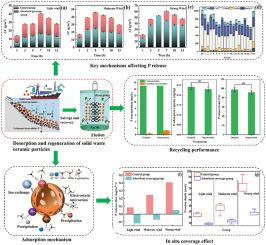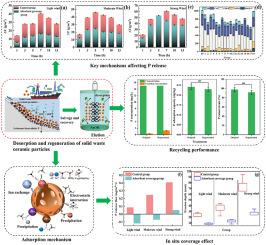Conversion of polluted sediments into sustainable phosphate-adsorbing ceramics
IF 10
1区 环境科学与生态学
Q1 ENGINEERING, ENVIRONMENTAL
引用次数: 0
Abstract
The management of sediment–water interfaces, particularly riverbed stability, is crucial for controlling pollutant buildup in sediments. Traditional restoration materials often face limitations such as unstable efficiency and high costs. This study developed ceramic particles from solid waste and examined the relationship between their coverage and phosphorus (P) release from sediment. Using Minitab to simulate the optimal raw material ratio (61.4 % dredged sediment, 14.4 % sewage sludge, and 24.2 % fly ash), we obtained ceramic particles with high P adsorption capacity (0.750 mg/g) and porosity (36.8 %). Characterization indicated that P adsorption was driven by chemical precipitation, ion exchange, and electrostatic attraction. In an in-situ remediation experiment, the particles significantly increased dissolved oxygen (0.462 → 5.26 mg/L), improved riverbed stability, and reduced erosion depth under wind disturbance by 63.8–64.1 %. Under weak to moderate winds, sediment resuspension decreased by 24.4 and 22.2 g/m2, and sediment P release flux was substantially lowered. Even under strong winds, the P release flux in the backfill group decreased by 87.2 % compared with the control. The process also followed the principle of “treating waste with waste,” as P resources were recovered using a simple NaOH leaching agent, enabling regeneration and reuse of the ceramic particles—remarkably, regenerated particles maintained adsorption performance with only minimal decline. In conclusion, solid waste ceramic particles represent a cost-effective and sustainable strategy for managing polluted sediments, while also facilitating P recovery and reuse. This work provides a theoretical basis for sediment pollution control and supports ecological governance and restoration of rivers and lakes.


污染沉积物转化为可持续吸附磷酸盐陶瓷的研究
沉积物-水界面的管理,特别是河床的稳定,是控制沉积物中污染物积聚的关键。传统修复材料往往存在效率不稳定、成本高等局限性。本研究从固体废物中提取了陶瓷颗粒,并研究了其覆盖度与沉积物中磷释放的关系。利用Minitab模拟最佳原料配比(61.4%的污泥、14.4%的污泥和24.2%的粉煤灰),得到了高磷吸附量(0.750 mg/g)和孔隙率(36.8%)的陶瓷颗粒。表征表明,磷吸附主要由化学沉淀、离子交换和静电吸引驱动。在原位修复实验中,颗粒显著提高了溶解氧(0.462→5.26 mg/L),改善了河床稳定性,使风蚀深度降低了63.8% ~ 64.1%。弱至中风条件下,泥沙再悬浮减少24.4 g/m2和22.2 g/m2,泥沙P释放通量明显降低。即使在强风条件下,回填组P释放通量也比对照降低了87.2%。该工艺还遵循“以废代废”的原则,使用简单的NaOH浸出剂回收P资源,实现陶瓷颗粒的再生和再利用——值得注意的是,再生颗粒保持了吸附性能,只有很小的下降。综上所述,固体废物陶瓷颗粒代表了一种具有成本效益和可持续的管理污染沉积物的策略,同时也促进了磷的回收和再利用。该研究为沉积物污染治理提供了理论依据,为河湖生态治理和修复提供了支撑。
本文章由计算机程序翻译,如有差异,请以英文原文为准。
求助全文
约1分钟内获得全文
求助全文
来源期刊

Journal of Cleaner Production
环境科学-工程:环境
CiteScore
20.40
自引率
9.00%
发文量
4720
审稿时长
111 days
期刊介绍:
The Journal of Cleaner Production is an international, transdisciplinary journal that addresses and discusses theoretical and practical Cleaner Production, Environmental, and Sustainability issues. It aims to help societies become more sustainable by focusing on the concept of 'Cleaner Production', which aims at preventing waste production and increasing efficiencies in energy, water, resources, and human capital use. The journal serves as a platform for corporations, governments, education institutions, regions, and societies to engage in discussions and research related to Cleaner Production, environmental, and sustainability practices.
 求助内容:
求助内容: 应助结果提醒方式:
应助结果提醒方式:


